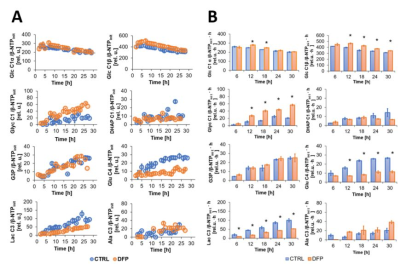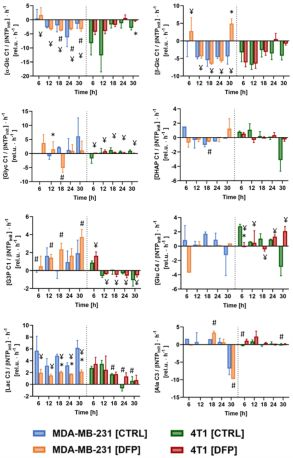1Medical Physics, Memorial Sloan Kettering Cancer Centre, New York, NY, United States, 2Department of Medicine, Memorial Sloan Kettering Cancer Center, New York, NY, United States, 3Molecular Pharmacology Program, Memorial Sloan Kettering Cancer Center, New York, NY, United States, 4Weill Cornell Medical College, Cornell University, New York, NY, United States

Effect of DFP on live MDA-MB-231 cell metabolism over time, as detected by 13C MRS. A: Average time course data of 1-13C-labeled Glc consumption and synthesis of [1-13C] Glyc, [1-13C] DHAP; [3-13C] G3P, [4-13C] Glu, [3-13C] Lac and [3-13C] Ala, are shown for DFP-treated (orange) and untreated (blue) MDA-MB-231 cells. B Average metabolite levels (mean ± SE) at different 6 h time intervals.
* Significantly different from untreated MDA-MB-231 cells (p<0.05, unpaired T test).

Comparison between the metabolite 13C-labeling rates of the human MDA-MB-231 and the murine 4T1 TNBC cells, (both, DFP-treated (DFP) and untreated (CTRL)), as detected by 13C MRS at each time point.
* Significantly different from untreated (CTRL) cells (p<0.05, unpaired T test).
# Significantly different from DFP-treated cells (p<0.05, unpaired T test).
¥ Significantly different from different time points (p<0.05, 2-way ANOVA with Geisser-Greenhouse correction
